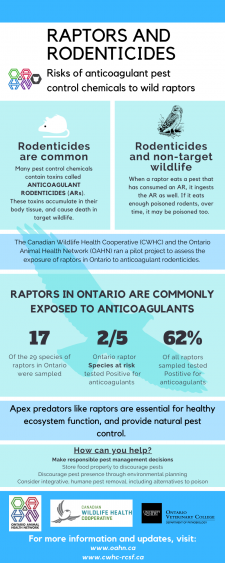OAHN Wildlife Network Research Project: Risks of anticoagulant pest control chemicals to wild raptors

Rodenticide exposure in non-target wildlife
Project Lead: Dr. Claire Jardine, CWHC
Date: February, 2020
Improper use of rodenticides can lead to non-target exposure and toxicity in humans, domestic animals, and wildlife. The Canadian Wildlife Health Cooperative (CWHC) previously identified several cases of rodenticide toxicity in non-target wildlife species; however, the extent rodenticide exposure in non-target Ontario wildlife is not known. The goal of this project was to assess the occurrence and distribution of anticoagulant rodenticide exposure in non-target wildlife, primarily raptors, in southern Ontario.
Between 2017 and 2019, 134 samples were collected from 17 raptor species in Ontario. Anticoagulant rodenticides, including bromadiolone, difethialone and brodifacoum, were detected in 62% of samples tested, representing 12 raptor species. Anticoagulant rodenticide was detected in 2 of 5 raptor species identified as species at risk in Ontario. Although this study effectively surveyed AR exposure in raptors across Ontario, the effects of AR exposure on individuals, populations, and the ecosystem still need to be investigated.
Click here to download the infographic
Click here to read the CWHC blog post on Raptors and Rodenticides


